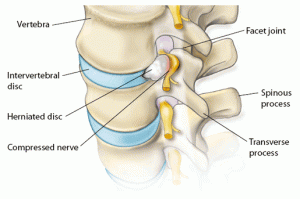Radicular, or sciatic, pain can present as an aching, throbbing, or stabbing pain and is commonly located in the back or outside of the thigh and in the calf or shin region of the lower leg. The pattern of complaints depends on the specific spinal nerve involved since each nerve supplies specific areas of skin and muscles within the lower extremity. The lower spinal nerves are more often affected since the lower lumbar spine demonstrates degenerative changes with the greatest frequency.
The pain is often activity related; any maneuver increasing the tension or pressure on the nerve, such as lifting a straightened leg or coughing, can produce a significant increase in pain. If more significant nerve irritation or damage occurs, pain may be replaced by numbness and isolated leg muscles may become weak.

A “foot drop” is a common weakness pattern associated with sciatica and involves an inability to bend the ankle in an upwards direction. On rare occasions a herniated disc can produce severe compression on multiple nerves causing weakness of the lower extremities, groin numbness, and loss of bowel or bladder control.
This condition, referred to as Cauda Equina Syndrome, is considered an emergent situation and requires immediate medical attention. However, cauda equina syndrome, as well as isolated weakness, is a rare manifestation of a herniated lumbar disc.

Discrete extension beyond disc confines, however a broad connection is maintained with interior of disc
When sciatic pain does not respond to conservative measures, progresses in frequency or severity, or if a patient presents with a neurologic deficit, involving numbness or weakness, surgery is indicated. The goal of surgery is to decompress the nerve by removing the cause of compression. When due to a herniated disc the procedure is known as a Minimally invasive Microdiscectomy. When due to lumbar stenosis the procedure most often performed is a Minimally invasive lumbar decompression. Occasionally, a combination of the two is required.

Dr. Ram R. Vasudevan, MD, FAANS
Austin NeuroSpine PLLC
5300 Bee Cave Road, Building 1,
Suite 220 Austin, TX 78746
Phone: (512) 640-0010
Monday: 8:00 AM – 5:00 PM
Tuesday: 8:00 AM – 5:00 PM
Wednesday: 8:00 AM – 5:00 PM
Thursday: 8:00 AM – 5:00 PM
Friday: 8:00 AM – 5:00 PM
Saturday: Closed
Sunday: Closed
© 2023 Austin NeuroSpine PLLC. All rights reserved.